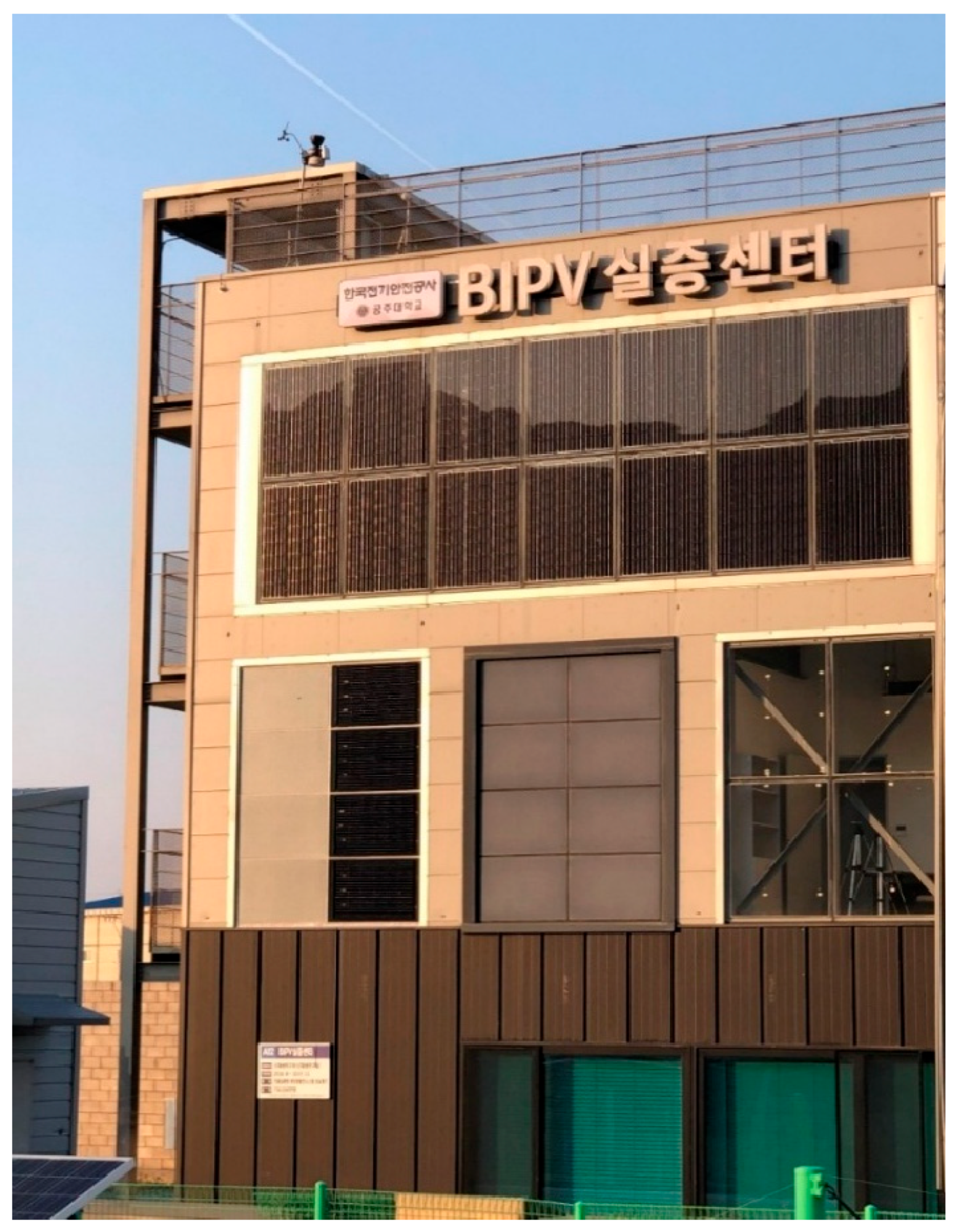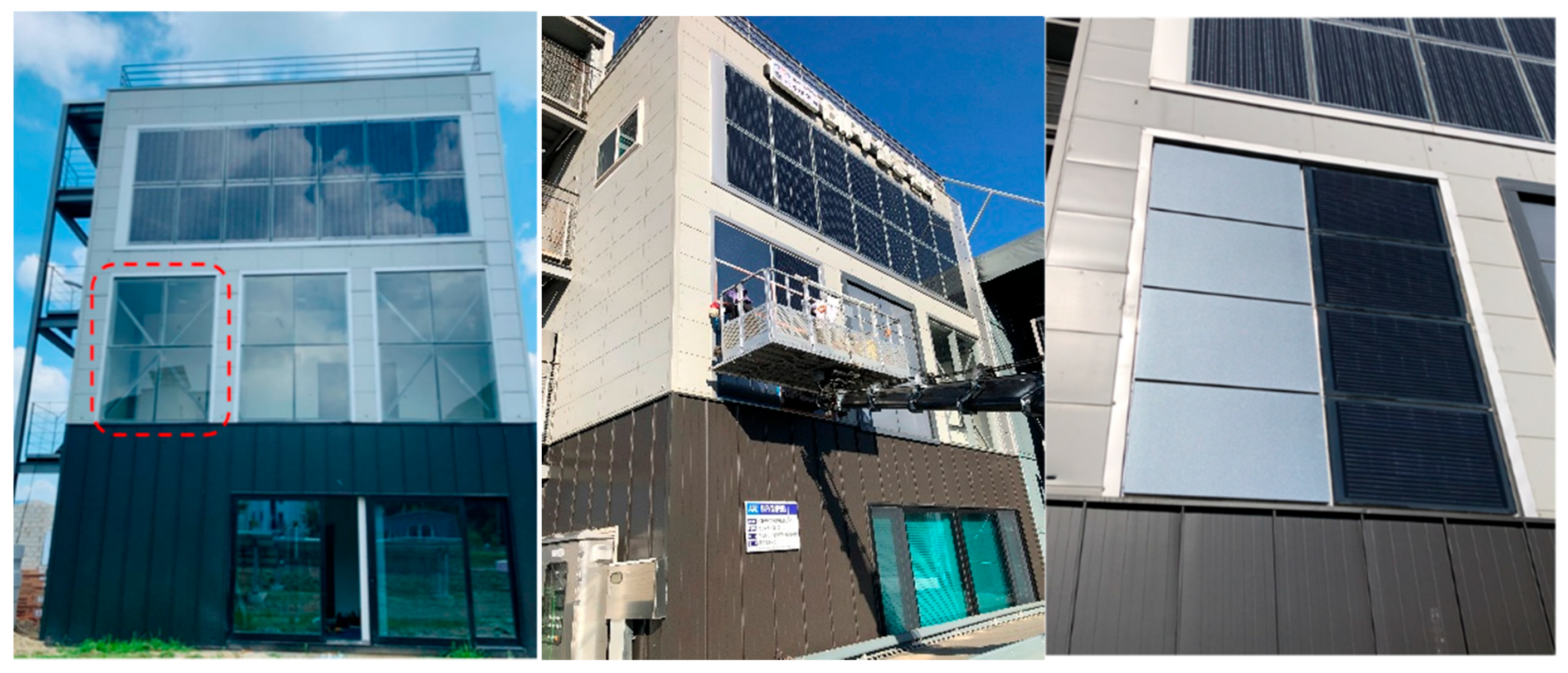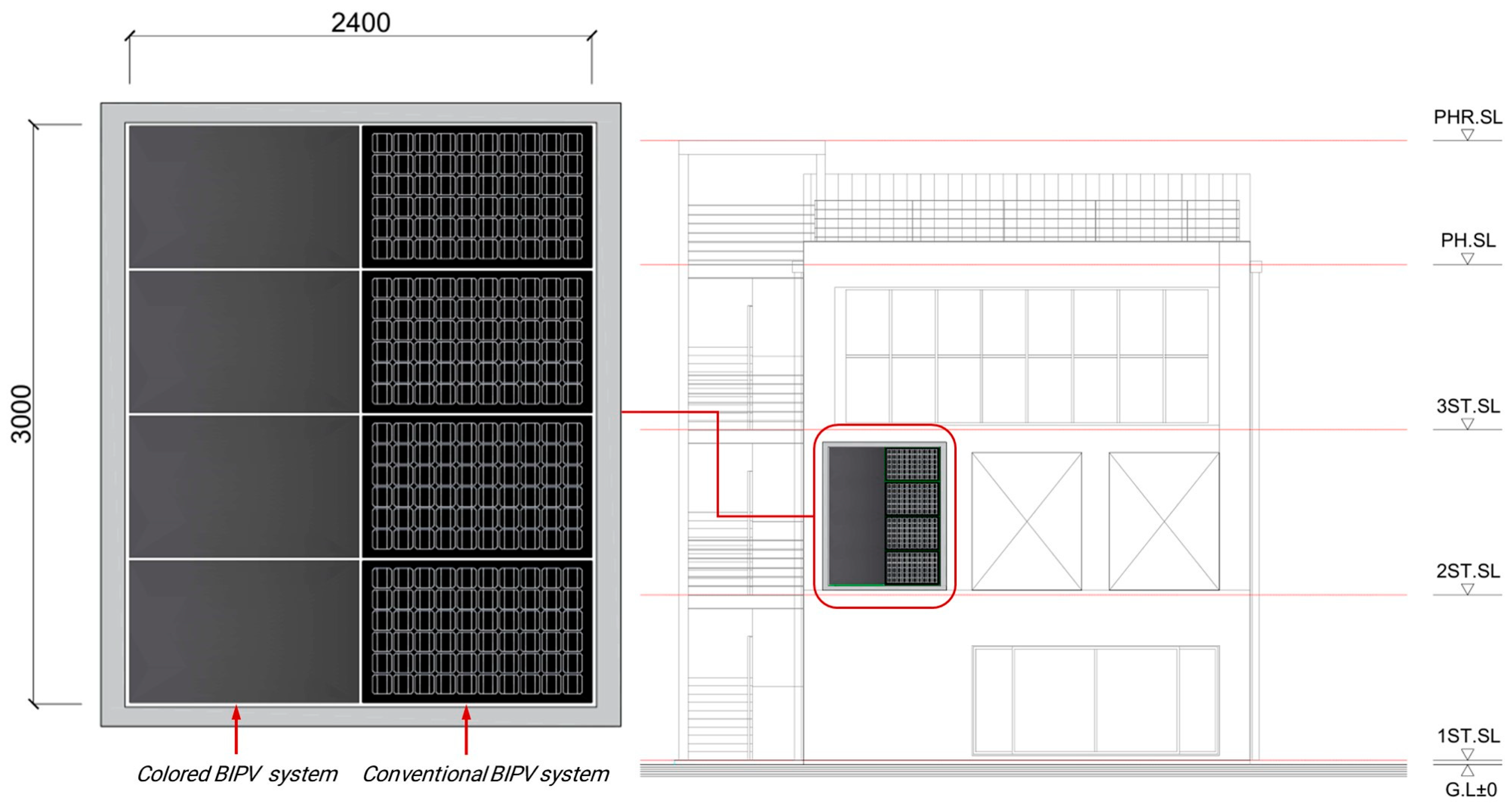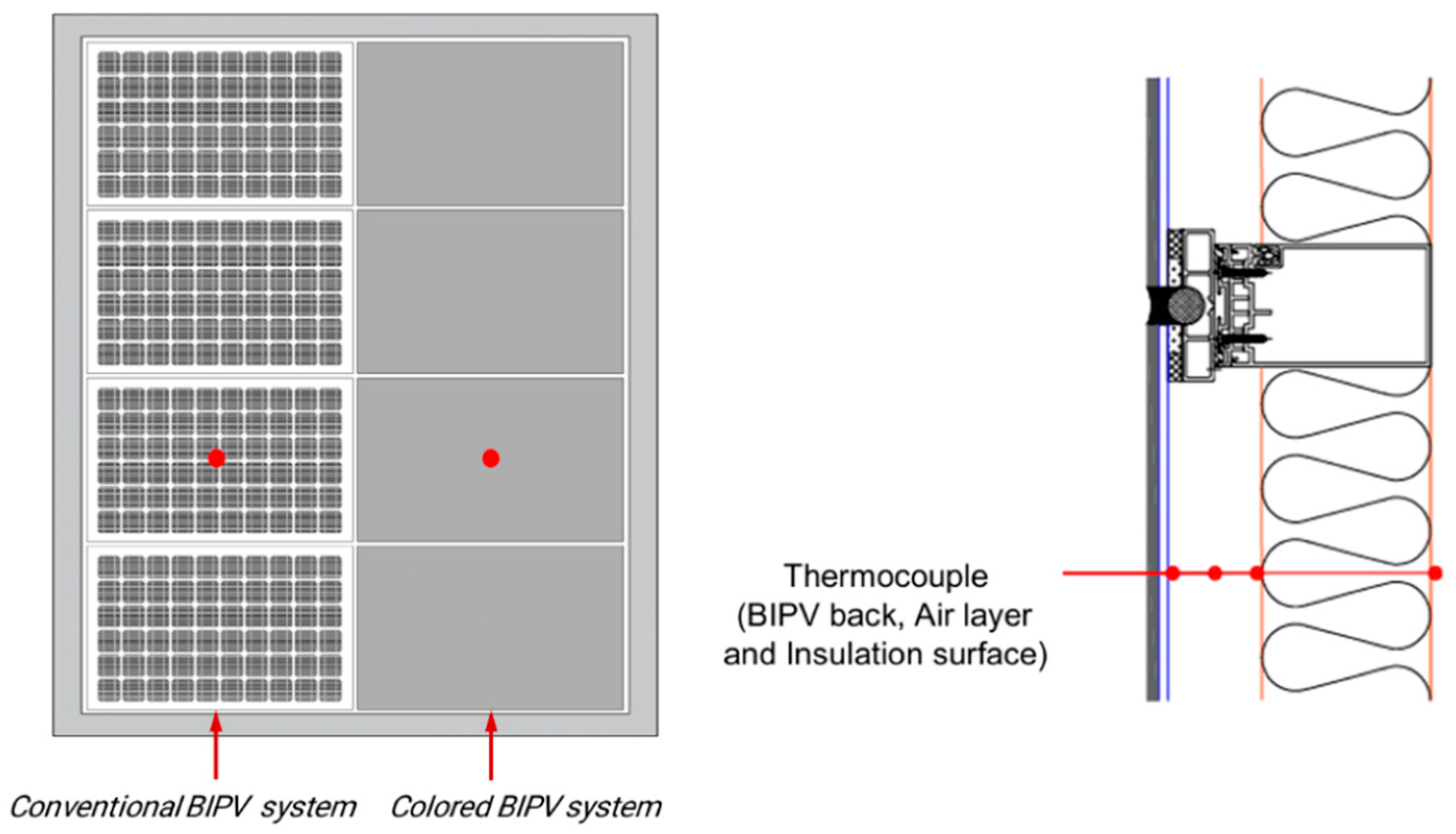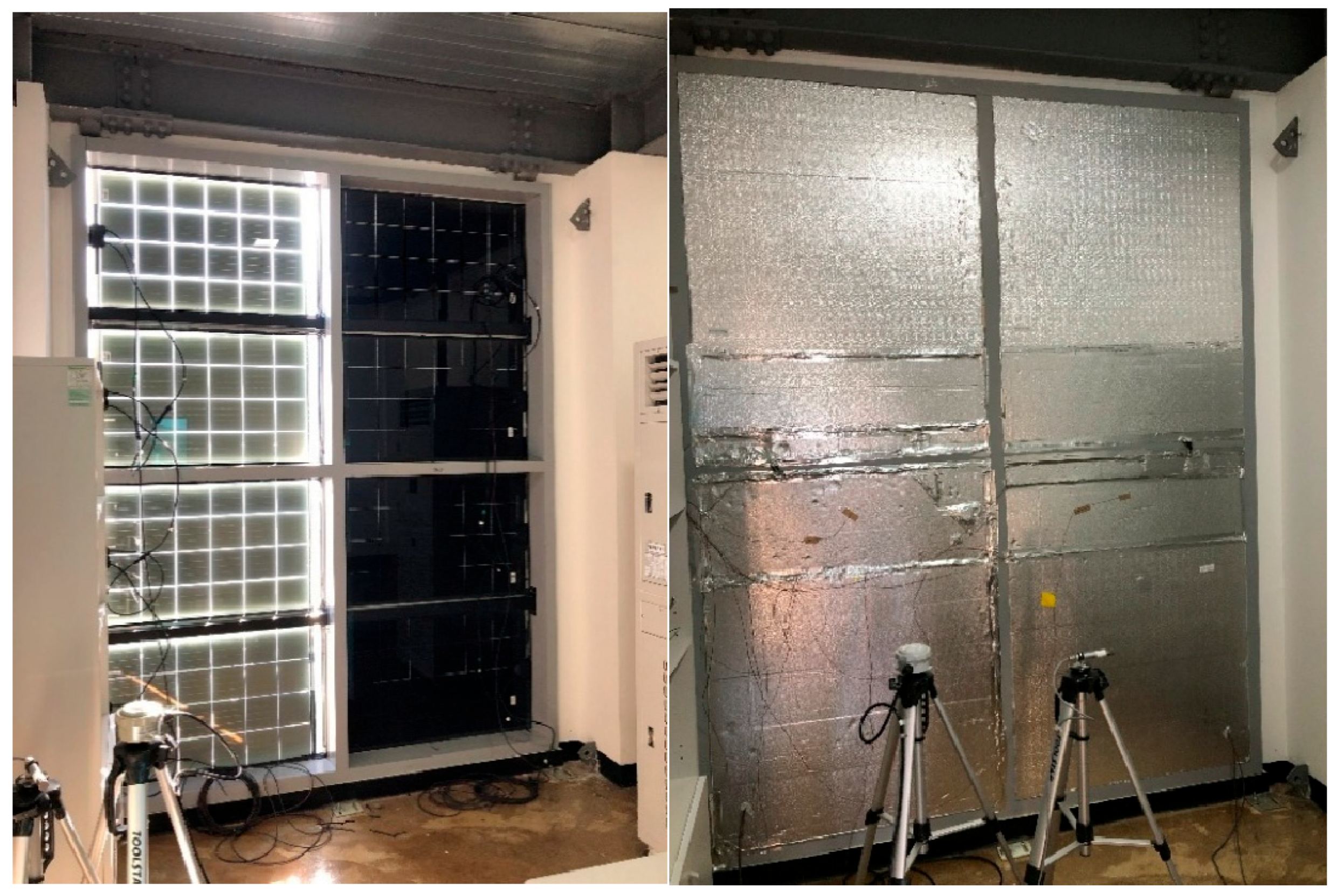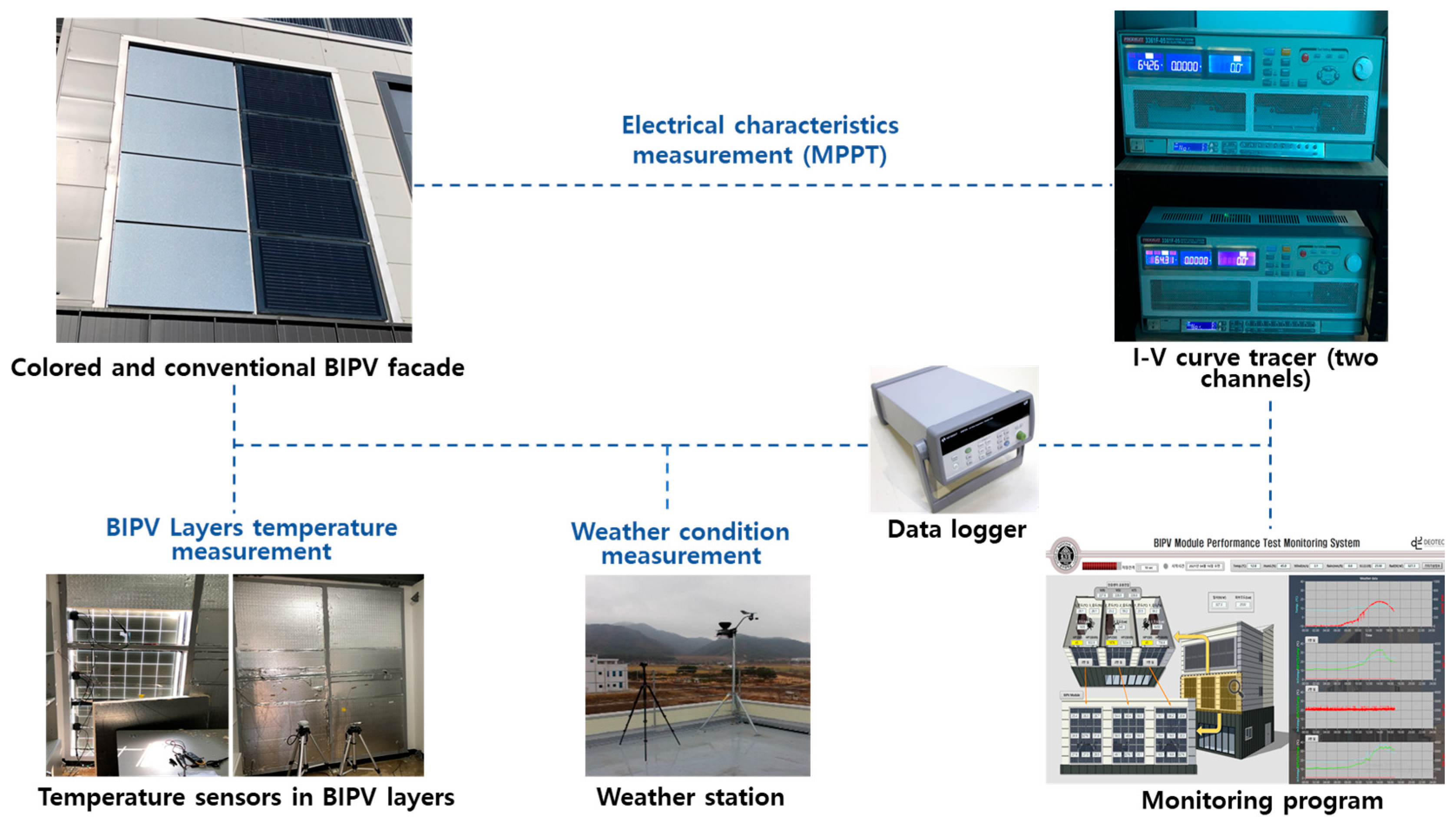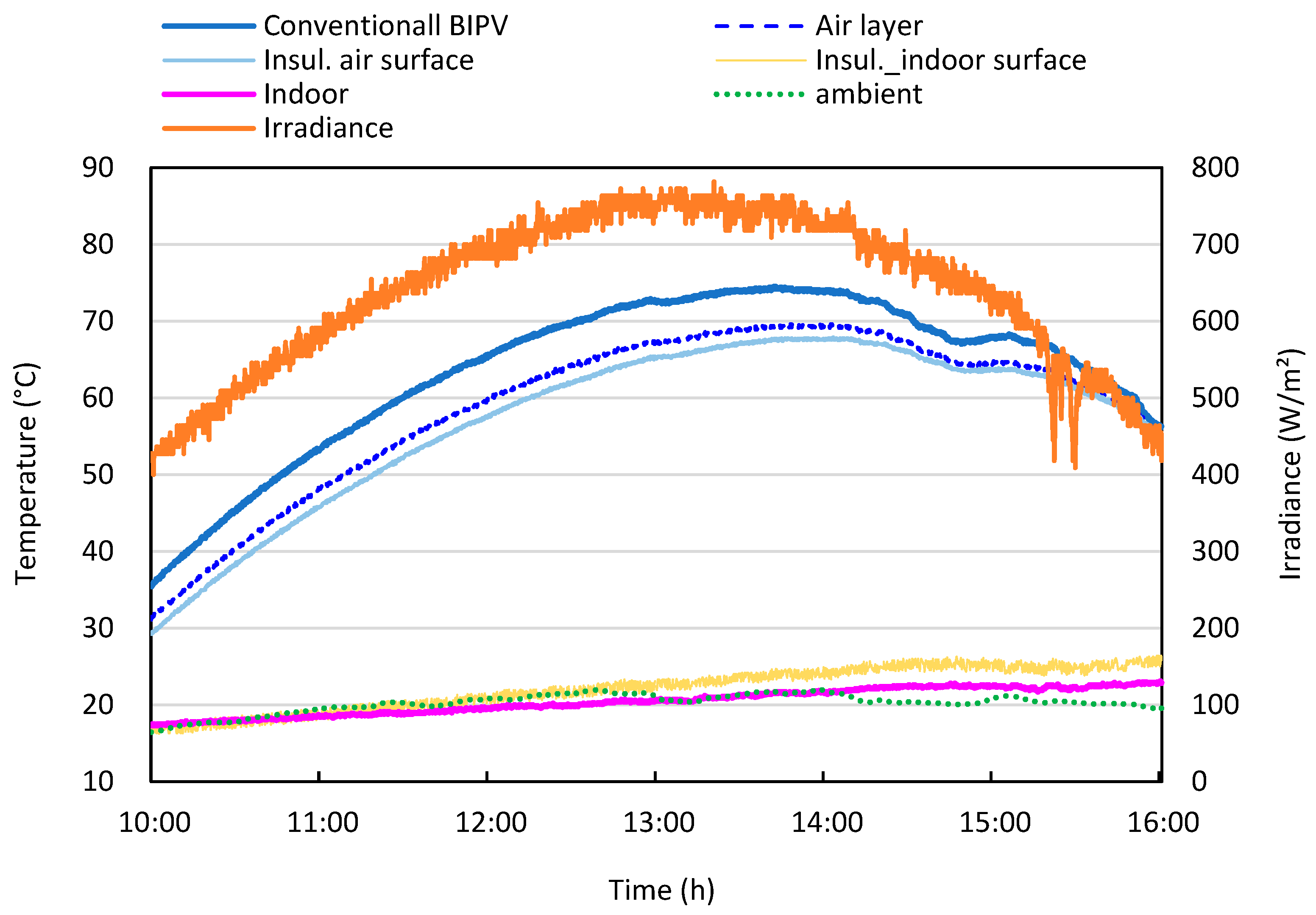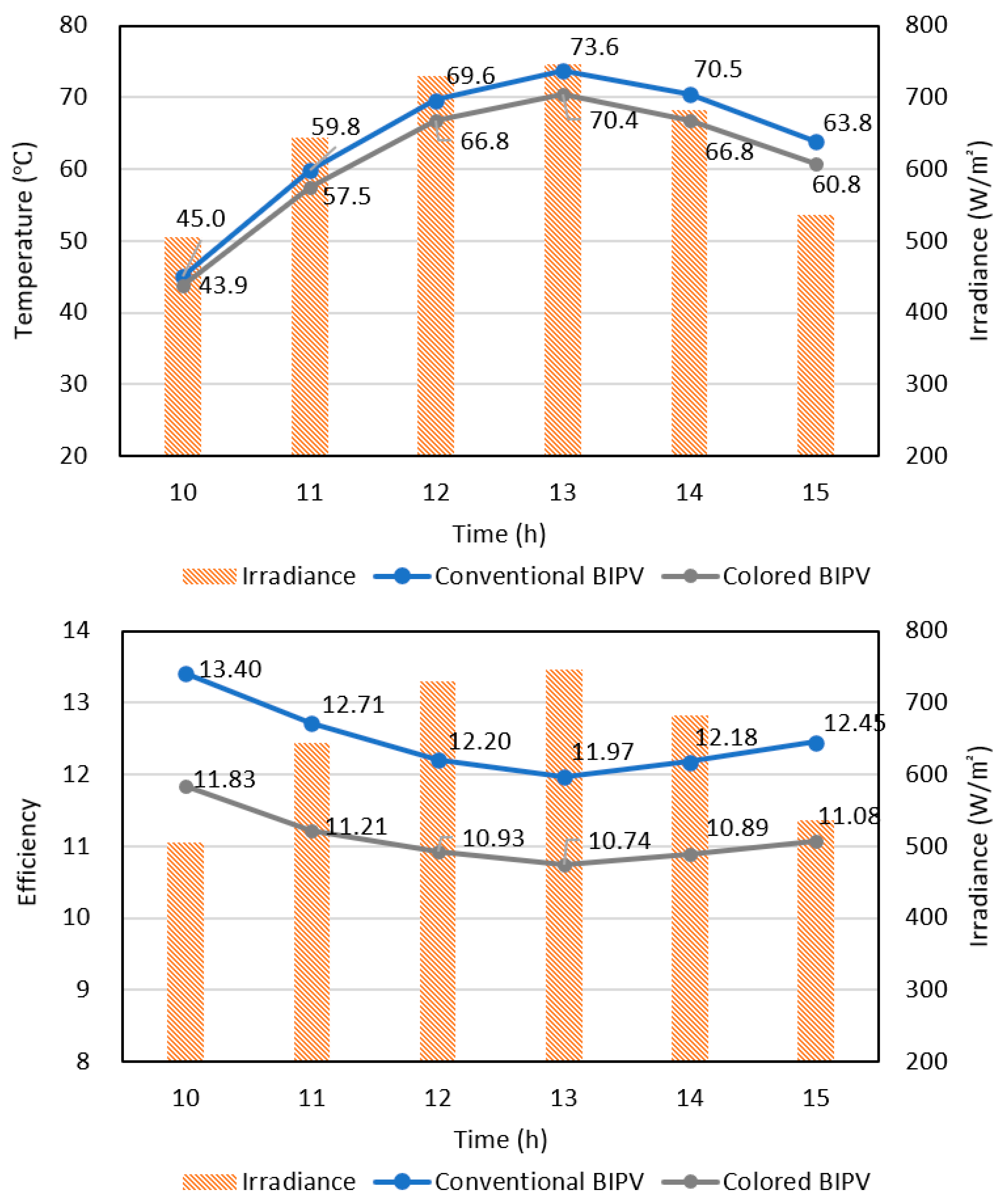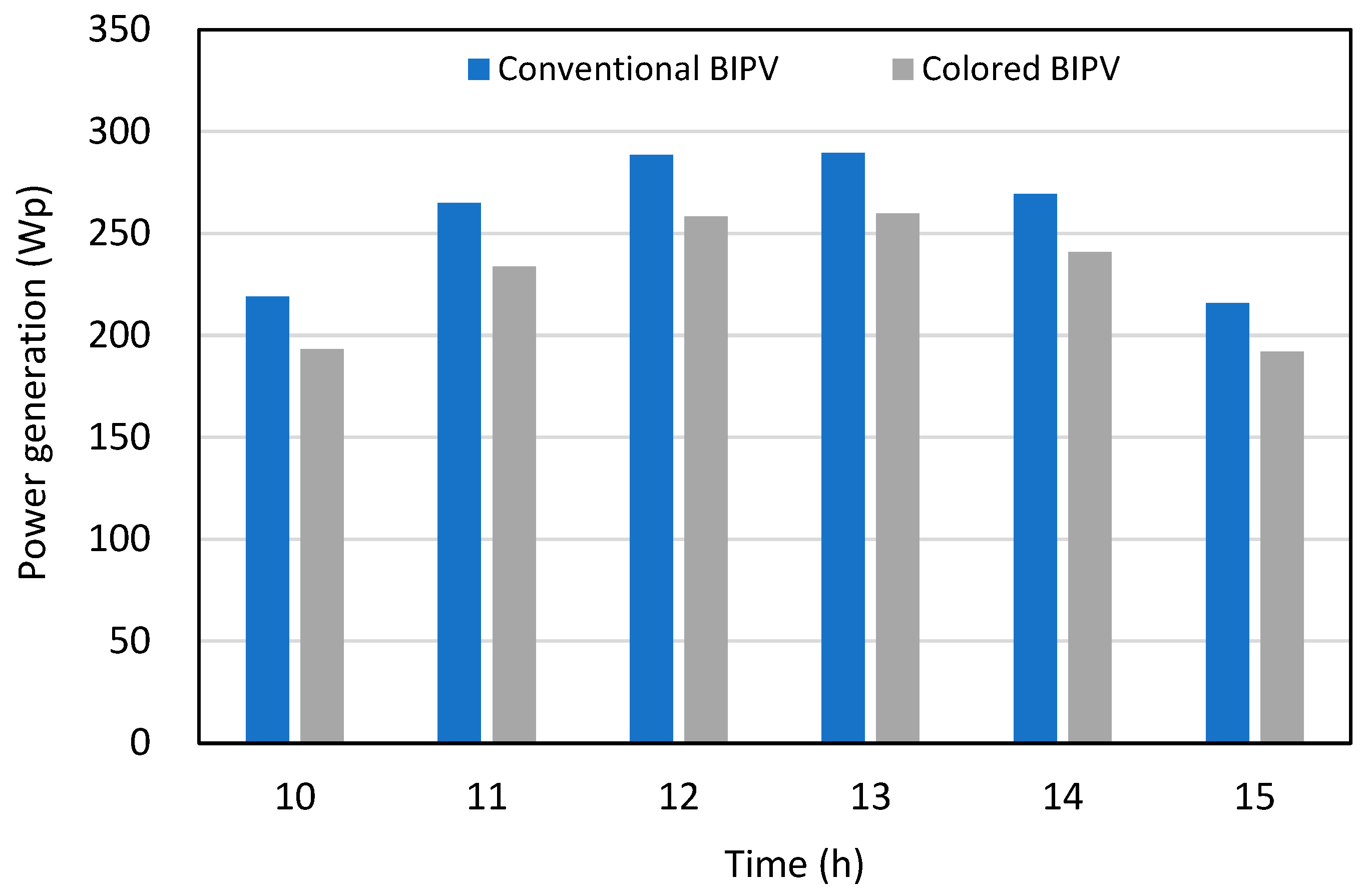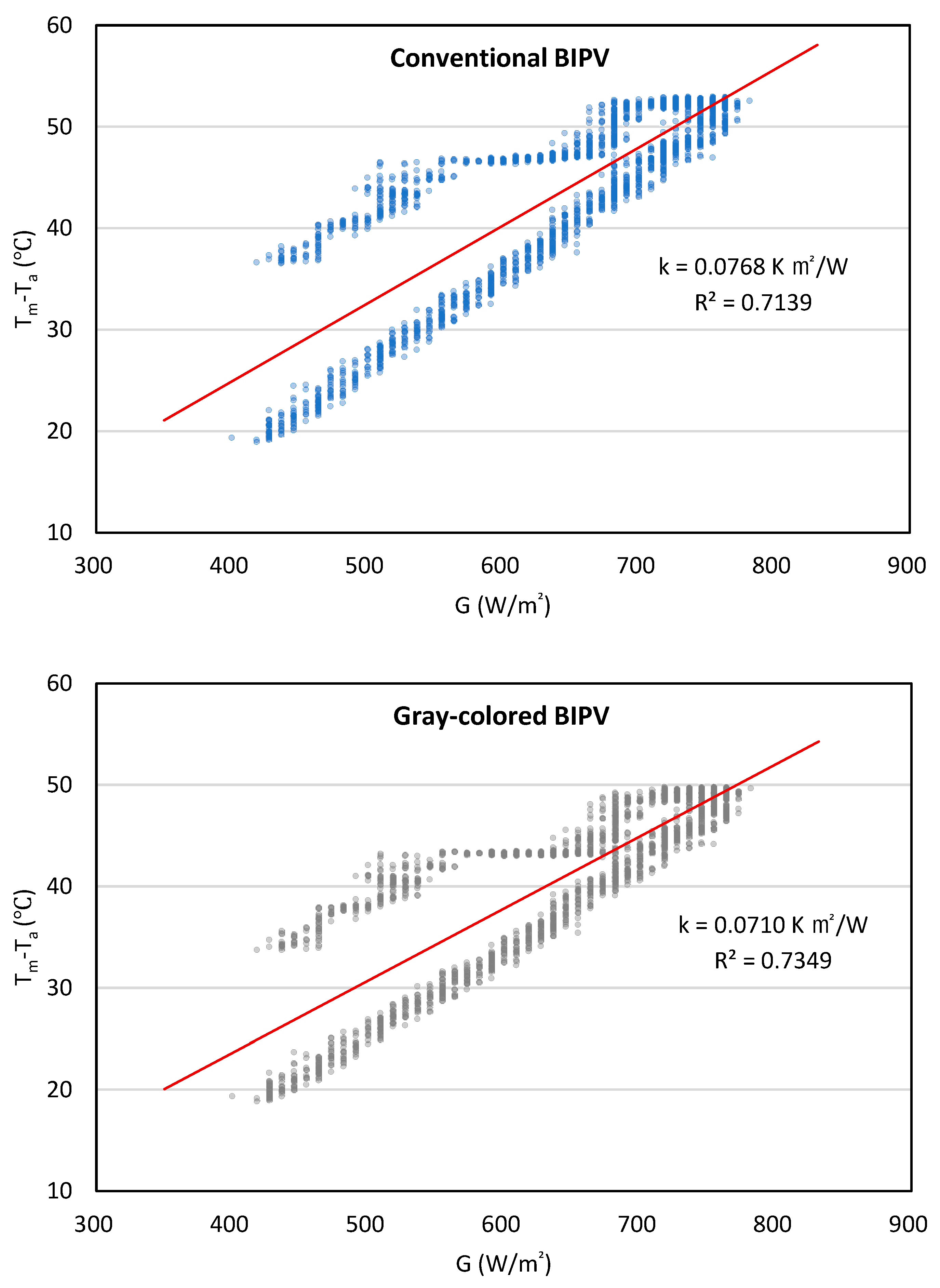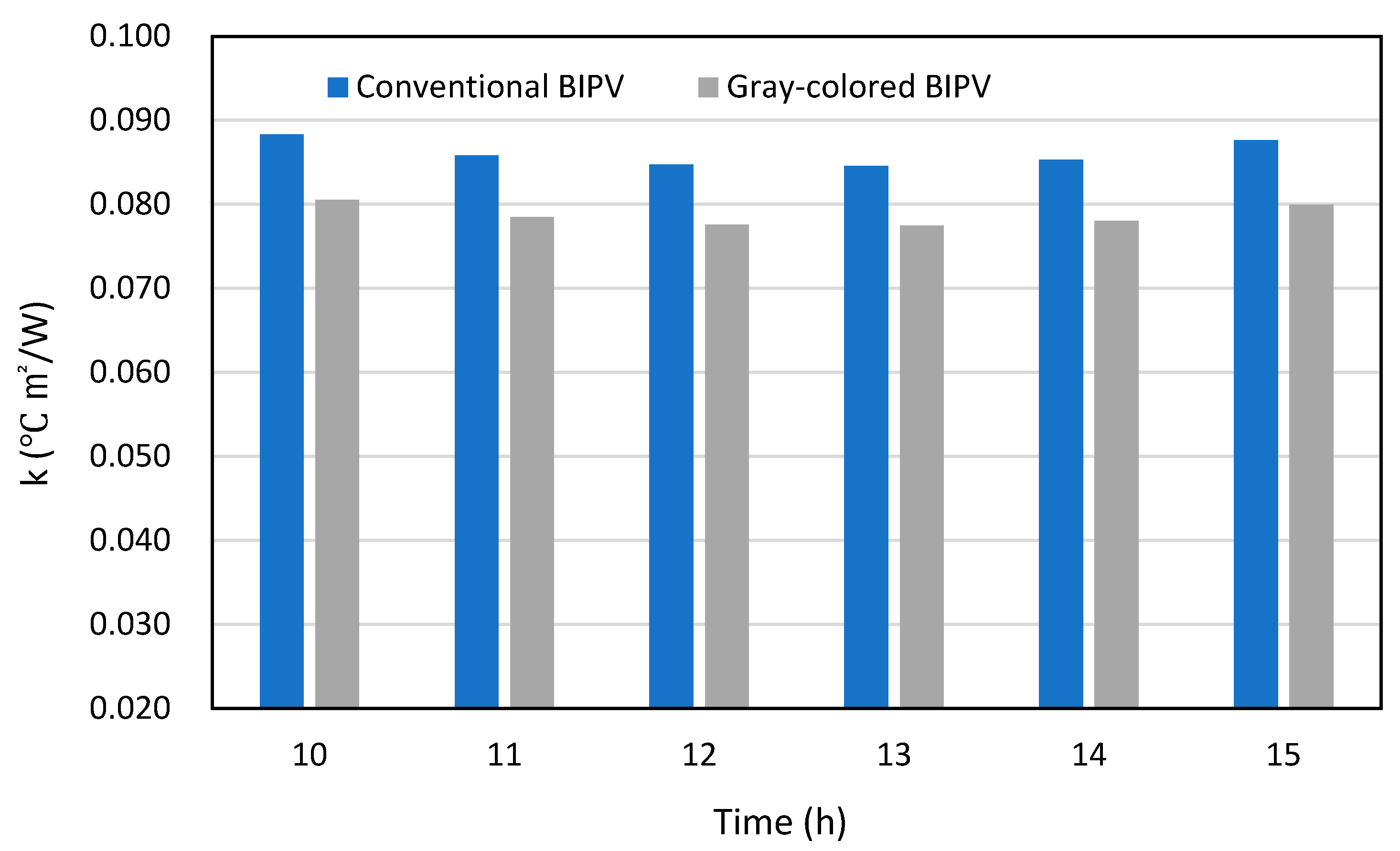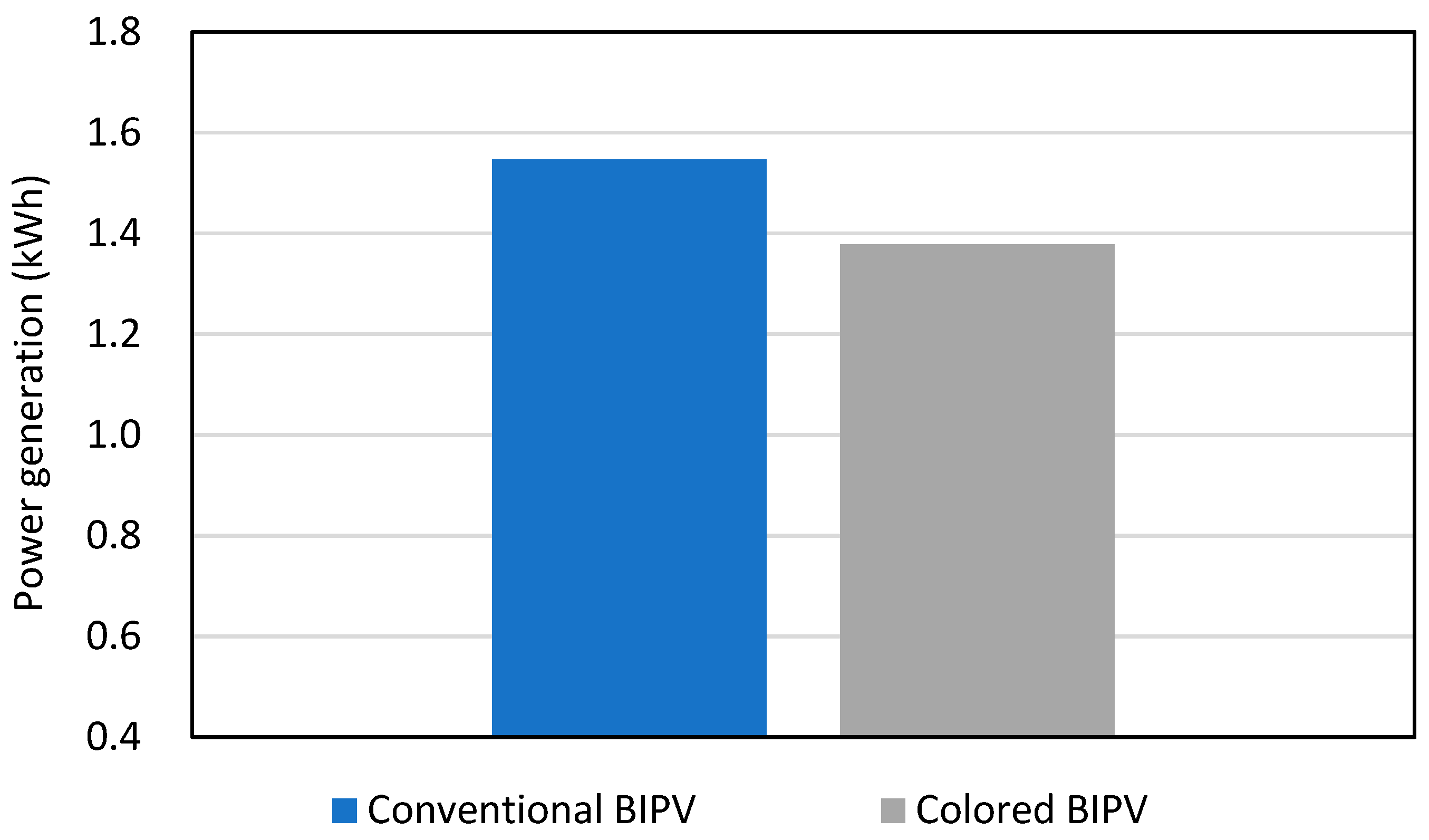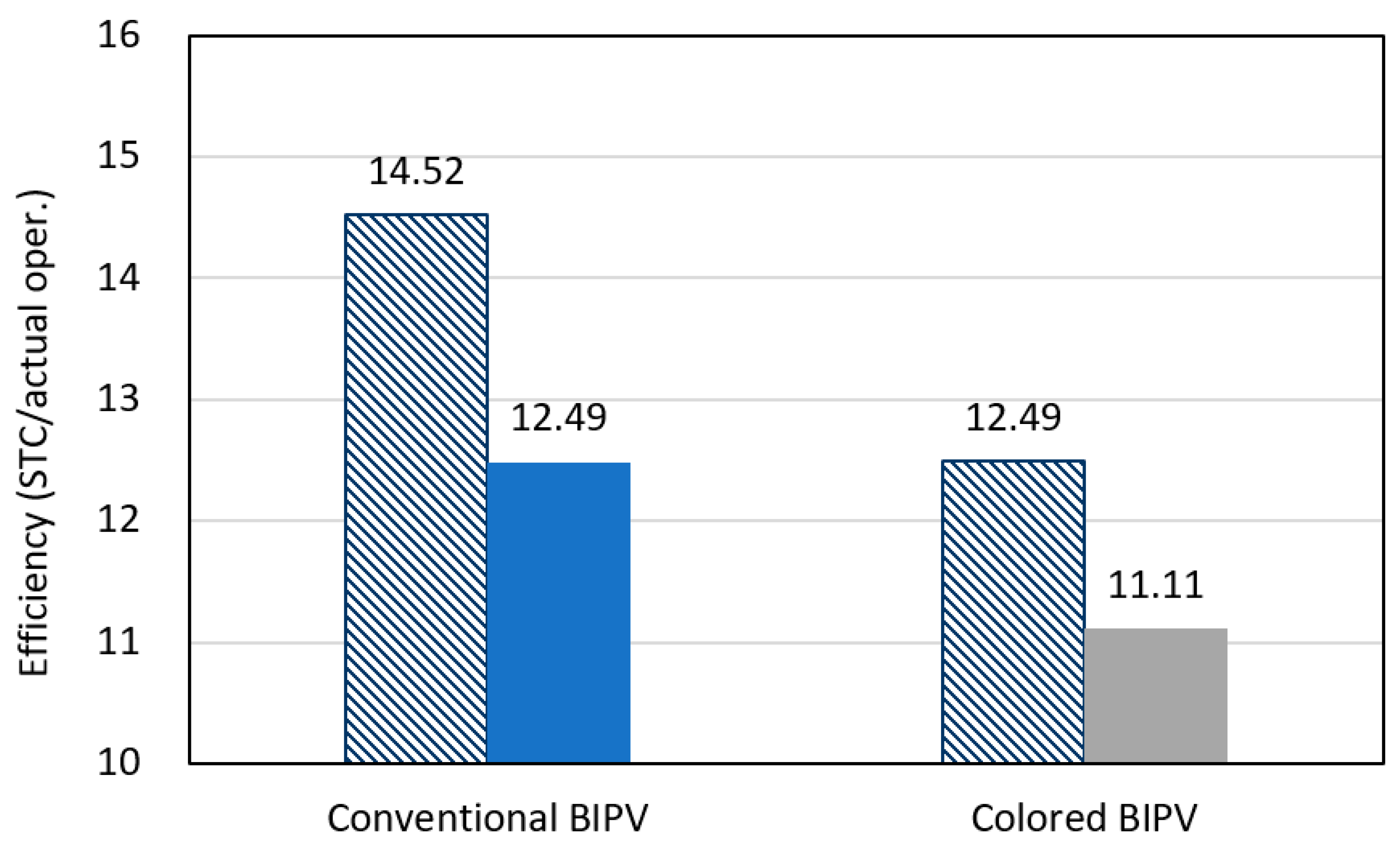1. Introduction
Building-Integrated Photovoltaics (BIPV) integrate Photovoltaics (PV) modules into the building envelope and represent a key technology for achieving Zero Energy Building (ZEB) targets through on-site power generation [
1,
2,
3]. BIPV systems eliminate the need for additional land for PV installation and are increasingly recognized as a high-value technology that can replace conventional building finishes. Nevertheless, their acceptance within the construction industry remains limited due to insufficient design information available to architects, low awareness among practitioners, and aesthetic concerns. To address these issues, colored PV modules in diverse colors have been developed, enabling BIPV systems to provide both power generation and architectural integration. These colored BIPV systems are gradually being adopted in the market, offering aesthetic appeal and harmony with building finishes [
4,
5]. However, unlike conventional BIPV systems, colored BIPV systems exhibit different performance characteristics in terms of temperature, electrical efficiency, and other factors due to the optical properties of the materials used, such as reflectance and transmittance, and thermal transfer differences based on rear insulation conditions. Therefore, a comprehensive performance evaluation considering these factors is necessary.
Tzikas et al. compared conventional PV modules with gray-colored modules and reported an efficiency reduction of approximately 8–10% for the gray modules [
6]. Nicolas et al. investigated a colored BIPV system installed on the Kohlesilo building in Basel, Switzerland, employing crystalline silicon glass-to-glass modules in five colors (black, green, blue, gray, and gold). Relative to black modules, gray and gold modules yielded approximately 76% of the energy output, while green and blue modules reached about 84% [
7]. Kutter et al. developed colored PV modules using ceramic-colored glass, Morpho-structure, and colored encapsulants, and evaluated their performance under Standard Test Conditions (STCs). Modules with ceramic-colored glass and colored encapsulants exhibited efficiency losses of 6–31% compared to standard PV modules, whereas Morpho-structured modules showed much smaller reductions of 3–7% regardless of color [
8]. Kroyer et al. corroborated these findings, demonstrating that red, green, and blue Morpho-structured modules maintained efficiency losses below 7% [
9].
Roverso et al. examined colored BIPV façades, measuring solar radiation and module temperature, and demonstrated that the Ross coefficient effectively represents the correlation between incident solar energy and internal module temperature [
10]. Babin et al. conducted outdoor experiments with modules in terracotta, green, red, beige, and gray, integrated into BIPV façades. They found no direct correlation between total optical losses and module temperature. However, higher reflectance reduced absorbed energy, contributing to lower module heating. Notably, lighter-colored modules, such as gray and beige, exhibited rear-surface temperatures up to 5 K lower than standard modules [
11]. Saretta et al. analyzed clear, blue, light gray, dark gray, and terracotta BIPV modules under STC and outdoor conditions. Dark gray modules exhibited the lowest maximum power (
Pmax) (13.43%), whereas blue modules achieved the highest efficiency among colored types. Outdoor experiments revealed color-dependent variations in efficiency and operating temperature; terracotta modules produced the lowest efficiency (~9.0%) but exhibited operating temperatures similar to clear modules (~45 °C) [
12]. Pelle et al. further highlighted that color layers induce distinct thermal behaviors, with Ross coefficients ranging from 0.0242 K·m
2/W (white) to 0.0456 K·m
2/W (mahogany brown), underscoring the significant role of color in thermal sensitivity [
13].
Zhihao et al. investigated crystalline silicon colored BIPV modules incorporating dielectric multilayer coatings and showed that optimized optical interference designs can achieve conversion efficiencies above 21% with photocurrent losses below 5% [
14]. Yuning et al. developed high-efficiency colored crystalline silicon PV modules in red, yellow, blue, green, and white using pearlescent pigments via screen printing. Their analysis indicated that efficiency losses were consistently below 20%, with green modules exhibiting the highest photocurrent density and lowest loss rates [
15]. Mahamoud et al. studied monocrystalline solar cells with colored filters under real climate conditions and found that relative power production strongly depended on filter color, yielding approximately 73% for yellow, 64% for red, and 54% for blue [
16]. Babin et al. also evaluated the long-term Direct Current (DC) Performance Ratio (PR) of colored PV modules. Their results revealed that reference and green modules exhibited the lowest annual PR (~0.86), while gray, beige, and terracotta modules achieved slightly higher values (0.88–0.89). Interestingly, red modules demonstrated the highest PR (~0.95), partly attributed to spectral mismatch gains during afternoon hours [
17]. Røyset et al. analyzed the application of optical interference coatings and provided design guidelines for balancing high color lightness, low efficiency losses, color performance, and angular dependence [
18].
Recent studies on colored BIPV indicate that architectural coloration—ceramic printing, pigment interlayers, colored encapsulants, and interference coatings—inevitably introduces optical-efficiency penalties, with the magnitude governed by color, technique, and angular response [
17,
18,
19,
20,
21,
22,
23,
24]. Field and modeling evidence further shows that high-reflectance (lighter) colors can moderate operating temperature at the façade by reducing effective absorptance, whereas darker tones increase thermal sensitivity often captured by the Ross coefficient (k) [
17,
18,
25,
26]. Despite the growing literature across theory/experiment/numerics, controlled, side-by-side façade experiments under identical boundary conditions remain scarce; reporting practices also vary in irradiance, sensor calibration, and Heating Ventilation and Air Conditioning (HVAC)/insulation configuration, complicating cross-study comparisons [
20,
22,
27].
Overall, prior studies consistently demonstrate that colored BIPV systems provide enhanced architectural integration but typically incur efficiency penalties due to optical and thermal effects. However, the magnitude of these penalties depends strongly on the coloration technique, the overall system configuration with the chosen building materials, and the environmental conditions. In particular, experimental evidence on Glass-to-Glass (G/G) crystalline silicon modules with gray coloration under practical building-like conditions remains limited. Against this backdrop, we provide a full-scale, façade-integrated comparison of gray vs. non-colored G/G c-Si modules, linking STC expectations to outdoor behavior with co-planar plane-of-array (POA) measurements.
This study aims to analyze the temperature characteristics and electrical performance of BIPV systems equipped with gray-colored G/G crystalline-silicon modules installed on a full-scale, façade-integrated mock-up building operated outdoors with an HVAC-controlled interior. To evaluate the impact of coloration, the results are compared with those of a conventional non-colored BIPV system. An air layer and rear insulation material were incorporated to replicate practical installation conditions. The gray coloration of the PV modules was selected considering aesthetics, harmony with surrounding buildings, and electrical efficiency. The modules were manufactured by digital printing, which provides high color fidelity while minimizing coloration-induced power losses.
3. Results and Discussion
3.1. Temperature Distribution of the BIPV Systems
Figure 8 and
Figure 9 illustrate the temperature characteristics of the gray and conventional BIPV systems installed on the building façade over the course of the representative measurement day. These figures focus on the temporal variation in temperature distributions across different layers of the BIPV assembly under real outdoor conditions. During the measurement period, the ambient conditions exhibited irradiance ranging from approximately 400 W/m
2 to 780 W/m
2 and outdoor temperatures fluctuated between 18 °C and 21 °C. The rear temperature of the gray BIPV modules ranged from approximately 33 °C to 68 °C, while the rear temperature of the conventional BIPV modules ranged from about 35 °C to 75 °C. The rear temperature of the gray BIPV modules was up to 7 °C lower than that of the conventional BIPV modules. The temperature in the air layer within the BIPV system was measured to be 5–6 °C lower compared to each module’s rear temperature. The temperature difference in the air layer for each BIPV system showed a similar pattern to the temperature difference in the module. The temperature of each component in the BIPV system decreased in the following order: BIPV module rear, air layer, insulation surface facing the air layer, and interior insulation surface. That is, the temperature was lower towards the interior.
All experimental data presented in
Figure 8,
Figure 9,
Figure 10,
Figure 11,
Figure 12,
Figure 13,
Figure 14 and
Figure 15 were obtained on 31 October 2021, under clear-sky conditions. The selected measurement day represents a typical autumn day with moderate irradiance levels and stable outdoor temperatures, which allows for a consistent comparative evaluation between the gray and conventional BIPV systems, and all subsequent analyses are based on this dataset.
3.2. Hourly Power and Efficiency Comparison
Figure 10 presents the irradiance-dependent thermal and electrical behavior of both systems, isolating the effect of solar input from temporal fluctuations. Both systems exhibited a distinct temperature rise with increasing irradiance, reaching their maximum values around 13:00, which coincided with near-solar-noon conditions (solar noon at 12:17 KST; solar altitude 38–39°, azimuth 195°) in Jeongeup, South Korea. These solar geometry values were obtained using the NOAA Solar Calculator provided by the National Oceanic and Atmospheric Administration (NOAA) [
31], based on the site coordinates (35.56° N, 126.84° E) and the measurement date (31 October 2021).
The peak rear-surface temperature of the conventional BIPV module was approximately 73.6 °C, while that of the colored BIPV module was about 70.4 °C, indicating that the colored module consistently maintained 2–3 °C lower temperatures. This suggests that the colored BIPV system possesses slightly improved heat dissipation characteristics compared to its conventional counterpart.
Regarding electrical performance, the conventional BIPV system showed a decrease from 13.4% to 12.4% over the observation period, while the colored BIPV system declined from 11.8% to 11.0%. Although both systems demonstrated a gradual reduction in efficiency with time, the conventional BIPV module consistently outperformed the colored module by approximately 1.5–2 percentage points. This discrepancy can be attributed to optical losses, such as reflection and absorption, introduced by the surface coloring treatment. The results indicate that the colored BIPV module exhibits a thermal advantage by operating at slightly lower temperatures, but this benefit is offset by reduced optical conversion efficiency. Conversely, the conventional BIPV module achieves higher absolute efficiency but is more vulnerable to performance degradation due to elevated operating temperatures. Furthermore, both systems experienced pronounced efficiency reductions during peak irradiance hours, highlighting the importance of thermal management strategies, such as improved ventilation and heat dissipation designs, for BIPV applications.
Figure 11 presents the hourly power generation and efficiency profiles of conventional and gray-colored BIPV modules. The conventional BIPV system consistently outperformed the colored BIPV system in terms of power generation across all measured hours. At 13:00, the peak power output of the conventional BIPV module reached approximately 290 W
p, compared to 260 W
p for the colored BIPV module, representing a difference of about 10%. This discrepancy can be attributed to optical losses introduced by the module colorization (gray), such as increased reflection and absorption. This performance gap was similarly reflected in the total daily energy yield, with the conventional and colored systems producing 1528 Wh and 1371 Wh, respectively.
3.3. Statistical and Ross Coefficient Analysis
Figure 12 illustrates the statistical distribution of temperature and electrical efficiency for conventional and colored BIPV modules. The rear-surface temperature of the conventional BIPV modules exhibited a median value of approximately 64 °C, with a range between 38 °C and 76 °C, while the colored BIPV modules showed a lower median of around 61 °C and a broader variation from 37 °C to 71 °C. These results indicate that the colored BIPV modules consistently operate at slightly lower temperatures, suggesting improved heat dissipation characteristics compared to conventional BIPV modules.
In terms of efficiency, the conventional BIPV modules achieved a median value of 12.5%, with the distribution spanning from 11.6% to 13.8%. By contrast, the colored BIPV modules presented a median efficiency of 11.0%, concentrated within a narrower range of 10.1% to 12.1%. This demonstrates that, despite the thermal advantage, the colored BIPV modules suffer from reduced electrical performance due to optical losses introduced by the surface coloring treatment.
Overall, the results highlight a trade-off between thermal and electrical performance: conventional BIPV modules exhibit superior electrical efficiency but are more vulnerable to high operating temperatures, whereas colored BIPV modules demonstrate enhanced thermal stability at the expense of conversion efficiency. These findings emphasize the need for advanced coloring technologies and optimized thermal management strategies to balance aesthetics, temperature regulation, and power generation in BIPV applications.
The Ross model can be interpreted as a first-order description in which the module-to-ambient temperature difference
Tm −
Ta scales linearly with
GPOA (Equation (2)). The coefficient
k can be attributed to combined effects of environmental conditions and module construction, and therefore exhibits system-specific values [
32].
As shown in
Figure 13, the relationship between the module-to-ambient temperature difference (Δ
Tm−a) and global POA irradiance (
G) was analyzed for both conventional and gray-colored BIPV systems using the Ross temperature model Δ
Tm−a =
kG + b. For the conventional BIPV module, the Ross coefficient was determined to be
k = 0.0768 K m
2/W with a coefficient of determination R
2 = 0.7139. In comparison, the gray-colored BIPV module exhibited a slightly lower Ross coefficient of
k = 0.0710 K m
2/W and a higher R
2 of 0.7349, indicating a marginal reduction in temperature rise per unit irradiance and a more stable thermal response.
Both systems showed a clear linear increase in ΔTm−a with increasing global irradiance in the range of approximately 350–850 W/m2, with temperature differences exceeding 50 °C under high irradiance conditions. This reflects the limited convective cooling capacity of façade-integrated PV systems compared to free-standing PV arrays. The slightly lower Ross coefficient observed for the gray-colored module could be attributed to reduced solar absorption and increased reflectance due to surface coloration. Nevertheless, the operating temperature remained high for both systems, which may lead to reduced electrical conversion efficiency and long-term material degradation.
As shown in
Figure 14, the hourly variation in the Ross coefficient
k was derived from linear regression between the module-to-ambient temperature difference (Δ
Tm−a) and global POA irradiance (
G) for both conventional and gray-colored BIPV systems. For the conventional BIPV,
k ranged from approximately 0.085 to 0.088 °C·m
2/W, while for the gray-colored BIPV, it remained lower, between 0.077 and 0.080 °C·m
2/W during the period from 10:00 to 15:00.
k value exhibited local maxima near 10:00 and 15:00, with a slight decrease toward solar noon. This systematic reduction suggests that surface coloration has a measurable influence on the thermal behavior of BIPV façades (the underlying drivers of the diurnal pattern cannot be identified from the present dataset alone).
These differences can be primarily attributed to the optical properties of the gray surface treatment, which reduce solar transmittance and mitigate heat accumulation within the module. By reflecting a larger portion of the incident radiation, the gray-colored BIPV module experiences less thermal gain under the same irradiance, leading to a lower Ross coefficient. The lower k values also indicate that gray-colored modules are less susceptible to temperature rise than conventional ones, suggesting improved thermal performance.
Furthermore, the relatively stable k profile throughout the daytime implies that this thermal advantage persists under varying solar conditions, including periods of peak irradiance. This observation supports the earlier regression results and reinforces the importance of surface optical design as a passive strategy for managing module temperature. In practice, such an approach may contribute to mitigating temperature-induced power losses and enhancing the long-term durability of colored BIPV façades.
3.4. Daily Energy Yield and STC vs. Outdoor Efficiency
Before presenting the results, we note that this study evaluates the relative power/energy reduction caused by gray colorization under real façade operating conditions. Because rated capacity and STC efficiency inherently differ due to the color layer, we report daily cumulative DC energy with simple normalizations (kWh/kWp, kWh·m−2) and focus on deviations from STC performance, rather than PR—which is a system-level AC index beyond our scope.
Figure 15 compares the daily energy yield for the conventional and gray-colored BIPV façade systems. The conventional façade produced about 1.55 kWh, whereas the gray façade generated about 1.40 kWh (≈10% lower). Over the same time window, the gray façade delivered 3.45 kWh/kW
p (gray) vs. 3.28 kWh/kW
p (conventional), while the area-normalized energy was 0.43 kWh·m
−2 (gray) vs. 0.46 kWh·m
−2 (conventional). The capacity-normalized advantage of the gray system indicates that its lower operating temperature partially offsets the optical penalty, yielding a higher relative energy per kW
p under real façade operation. Conversely, when normalized by aperture area, the conventional system retains a slight advantage due to its higher nameplate per area. Taken together, gray coloration can be favorable for architecturally integrated applications where aesthetics and thermal stability are prioritized and performance is compared on a per-kW
p basis, while absolute yield per unit area remains marginally lower.
Figure 16 compares the efficiencies of conventional and gray-colored BIPV modules under standard test conditions (STCs) and actual outdoor operation. Under STCs, the conventional BIPV module achieved an efficiency of 14.52%, while the colored BIPV module recorded 12.49%. Under real operating conditions, both systems showed a reduction in efficiency, with the conventional BIPV at 12.49% and the colored BIPV at 11.11%. The colored BIPV module consistently exhibited lower efficiency than the conventional module under both STC and outdoor conditions. The efficiency gap was approximately 2%p under STCs and 1.4%p under real operating conditions. The relative efficiency losses were calculated to be about 15% for the conventional BIPV and 10% for the colored BIPV. This indicates that the colored module experiences less efficiency loss under real operating conditions compared to the conventional module, reflecting the relatively higher thermal stability of the colored BIPV system.
3.5. Discussion
Although numerous studies have investigated the performance of colored Building-Integrated Photovoltaic (BIPV) systems [
6,
7,
8,
9,
10,
11,
12,
13,
14,
15,
16,
17,
18], most of them focused on laboratory-scale testing or Standard Test Condition (STC) evaluations, providing limited insight into real façade operation. These works primarily assessed the optical and electrical effects of coloration, but the complex interaction between optical, thermal, and electrical parameters under dynamic outdoor conditions has not been sufficiently addressed. Moreover, reported results are often difficult to compare because the boundary conditions differ significantly among studies, particularly in terms of rear insulation, air-gap depth, and ventilation, all of which have a strong impact on the Ross coefficient (
k). Consequently, the
k values presented by different authors cannot be directly compared, and their implications for façade-integrated systems remain uncertain.
In addition, most previous studies treated color as a categorical property—such as “gray,” “blue,” or “terracotta”—without quantitative colorimetric or spectral characterization (e.g., CIE Lab values or wavelength-dependent reflectance). This lack of standardized optical data has hindered a clear understanding of how reflectance and absorption govern module temperature rise and efficiency loss. Several experimental works [
10,
11,
12,
13] discussed color-dependent module temperatures, yet they often analyzed thermal and electrical behaviors separately, thereby neglecting the coupled influence of irradiance, module temperature, and instantaneous efficiency. Reported Performance Ratios (PRs) for colored BIPV systems also vary in definition, mixing DC-based and AC-based formulations without clear temperature or spectral correction, which complicates long-term performance comparison. Furthermore, many previous investigations were carried out using coupon-sized or non-integrated samples rather than full-scale building façades, limiting their representativeness for practical building applications. To overcome these limitations, the present study compared the thermal and electrical behavior of conventional and gray-colored glass-to-glass BIPV systems under identical boundary conditions, using STC results as a baseline and extending the evaluation to real façade-integrated outdoor operation. The gray-colored module exhibited a consistently lower rear-surface temperature and smaller relative efficiency loss despite a moderate optical-efficiency penalty. These results are consistent with the findings of Babin et al. [
11] and Saretta et al. [
12], but this work further demonstrates, under realistic building-façade configurations, that gray coloration can reduce operating temperature and maintain electrical performance stability compared with STC expectations.
Overall, the results indicate that, while coloration introduces optical losses, the gray color layer reduces effective solar absorptance, lowering heat input to the façade assembly and thereby providing a tangible thermal advantage that enhances operational stability under real building conditions. The lower temperature of the gray-colored BIPV is attributed primarily to reduced effective absorptance caused by the color layer (i.e., increased reflectance), rather than to ‘enhanced heat dissipation,’ thereby decreasing the fraction of incident POA irradiance that is absorbed and converted to heat. This underscores the importance of field-scale experiments in bridging the gap between STC-based assessments and actual façade-integrated performance.
This study intentionally focuses on a controlled, façade-integrated comparison on a single clear-sky day to isolate the coupled optical–thermal effects of gray coloration. Accordingly, the findings should be interpreted as indicative trends rather than generalized values across all climates or operating scenarios. The scope is limited to one façade configuration with fixed orientation and insulation; detailed 1D/2D thermal modeling or CFD, spectral/colorimetric measurements, and IR thermography were outside the present measurement protocol and are therefore not included. These complementary analyses lie beyond the current scope and may be explored in follow-up campaigns with multi-day/seasonal datasets and varied wind regimes.
4. Conclusions
This study experimentally evaluated the thermal and electrical performance of conventional and gray-colored glass-to-glass BIPV systems installed on a full-scale mock-up building façade, comparing their behavior under real outdoor conditions against STC-based reference performance.
The outdoor results showed that the conventional BIPV module reached a maximum rear-surface temperature of 75 °C, while the gray-colored module remained lower at 68 °C, corresponding to a temperature difference of 3–8 °C depending on irradiance. Although the colored module exhibited approximately 10% lower daily energy yield, its relative efficiency loss under real conditions was smaller (≈10%) than that of the conventional module (≈15%), confirming its superior thermal resilience and stability. These findings reveal that, while colorization inevitably causes optical losses, it mitigates excessive heat accumulation within insulated façades, thereby improving long-term reliability. The results highlight a clear trade-off between conversion efficiency and architectural aesthetics: conventional systems offer higher power output, whereas colored systems provide improved thermal stability and visual integration. Importantly, by comparing STC-based expectations with actual façade performance, this work provides experimental evidence of the electro-thermal correlation unique to real-world BIPV applications.
Future research should focus on extending the investigation to BIPV systems with various colorizations and insulation configurations, not limited to gray coloration, in order to comprehensively analyze the optical losses and thermal behavior associated with different color layers. The goal is to develop optimized BIPV technologies that minimize optical losses while ensuring adequate energy yield and stable operation for real building applications.
In addition, further studies should consider multiple weather conditions, including cloudy and partly cloudy days, to establish a more generalized relationship between thermal behavior and environmental variables. Advanced analytical approaches, such as multi-linear regression and optimization techniques, will be applied to explore the boundary conditions for optimal thermal performance. Moreover, economic feasibility assessments, including payback period analyses, will be incorporated to strengthen the practical applicability of the results.
